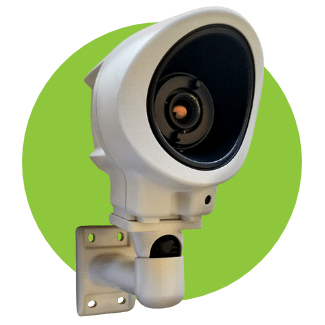
In the ever-evolving landscape of technology, particularly in the industrious expanses of Western Canada, devices like thermal cameras are becoming increasingly integral. But what is a thermal camera, and how does it differentiate from its infrared counterpart?
Discover the mysteries behind these innovative tools and read on to explore their significance in regions like Edmonton and Calgary.
What is a Thermal Camera?
Thermal imaging cameras are specialized devices that convert infrared radiation (heat) emitted by objects into visible light images. These images allow users to see temperature variations, hence detecting people, animals, or objects in complete darkness, through smoke, or in challenging weather conditions. The technology, initially developed for military applications, has since become invaluable across many fields, including public safety, industrial maintenance, and health diagnostics.
The core principle behind thermal imaging is the detection of infrared radiation, which is emitted by all objects based on their temperatures. This radiation is invisible to the human eye, so thermal cameras use sensors to capture it, creating a thermogram. Then, the thermal cameras translate this thermogram into an electronic image displayed in various colors that represent different temperatures. Advanced thermal cameras provide detailed images that allow for precise temperature measurements, crucial in applications such as electrical inspections, where overheating components can be identified before they fail.
Key attributes of thermal cameras include their resolution and thermal sensitivity. Higher resolution cameras produce clearer images, making it easier to identify and diagnose issues. Thermal sensitivity refers to the camera’s ability to detect minute differences in temperature, essential for identifying subtle but critical problems that could lead to equipment failure or safety hazards.
Despite their versatility, thermal cameras have limitations. They cannot, for example, see through glass or walls. This is because glass and walls have their own heat signatures and block the infrared radiation from objects behind them. Understanding these limitations is essential for effectively using thermal imaging cameras in various applications.
Infrared Camera vs Thermal Camera
Active infrared (IR) systems and thermal imaging technologies differ fundamentally in their approach to capturing images. Active IR systems use a form of light illumination that’s invisible to the naked eye, shining infrared light onto objects and capturing the reflection with a sensor. This technique is similar to how a standard camera operates, but in a different spectrum. These systems rely on an external source of IR light, making them less effective in complete darkness without their light source.
On the other hand, thermal imaging does not require any external light source. Instead, it captures the natural heat emitted by all objects, known as thermal radiation. By detecting subtle differences in temperature, thermal cameras can create a detailed image that highlights temperature variations in the scene. This capability allows thermal imaging to be particularly effective in complete darkness, through smoke, fog, or haze, where traditional and active IR cameras would struggle.
The choice between active IR and thermal imaging depends on specific needs and conditions. Active IR might be preferred in controlled environments where the presence of light can be managed. In contrast, thermal imaging is ideal for situations requiring visibility regardless of lighting conditions, providing critical information in complete darkness or obscured environments.
Applications in Western Canada
In Western Canada, thermal and infrared cameras serve critical roles across various sectors. In the oil and gas industry, thermal imaging helps in monitoring pipeline integrity, detecting leaks that are invisible to the naked eye. For forestry management, these cameras assist in early fire detection, significantly reducing potential damage.
Urban areas like Edmonton and Calgary benefit from thermal imaging for building inspections, energy efficiency assessments, and supporting law enforcement in search and rescue missions. The versatility of these technologies underscores their importance in the diverse landscapes and industries of Alberta.
Advancements and Innovations
The field of thermal imaging is rapidly advancing, with new technologies enhancing their applications. Recent innovations include higher resolution sensors for more detailed images and AI integration for smarter analysis and decision-making.
These advancements have expanded their use beyond traditional sectors, facilitating widespread adoption in environmental monitoring, healthcare, and even consumer electronics. As these technologies evolve, industries stand to gain from improved efficiency, safety, and environmental stewardship.
Choosing the Right Camera for Your Needs
Selecting a thermal camera depends on specific needs and environmental conditions. For indoor applications or controlled environments, infrared might suffice. However, for outdoor activities in Alberta’s unpredictable weather, thermal cameras offer superior detection and visibility.
Consider factors like the required range, image resolution, and environmental conditions. Consulting with experts can provide tailored advice, ensuring that individuals and businesses in Western Canada choose the most appropriate technology for their specific requirements.
Safety and Maintenance
Maintaining the operational integrity of thermal cameras is crucial. Regular maintenance checks ensure these devices perform optimally, providing reliable data. Adhering to safety protocols protects users and extends the lifespan of these sophisticated instruments.
Proper handling, storage, and routine checks are essential for leveraging the full potential of these cameras, ensuring they continue to serve as invaluable tools in various applications.
Contact Tridon Communications Today
Understanding the nuances of thermal imaging technology, from recognizing what is a thermal camera to differentiating between an infrared camera and a thermal camera, is vital for professionals across numerous industries in Western Canada and beyond. Whether it’s for security, energy efficiency, or emergency services, a camera that detects heat can be an invaluable asset.
If your operations could benefit from the advanced detection capabilities of a heat sensor camera, or if you’re seeking to understand more about how thermal cameras work, Tridon Communications is here to assist. Our expertise and range of solutions are tailored to meet the unique challenges and conditions of this region. Don’t hesitate to reach out for more information or to discuss how we can support your thermal imaging needs.



